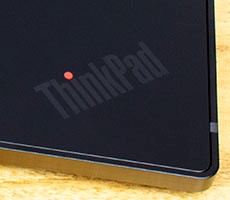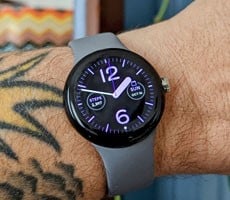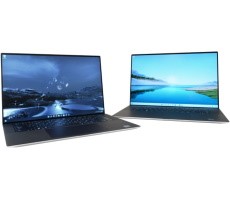Lenovo ThinkPad Z13 Review: A Sleek, Fast Ryzen Pro Laptop
ATTO Disk Benchmark
ATTO disk benchmark is a quick test that measures sequential read/write bandwidth across a range of different data sizes. While we don't typically compare these results across multiple machines, though it's useful to gauge whether a particular notebook's storage subsystem is up to par.Lenovo endowed the ThinkPad Z13 with a PCI Express 4.0 SSD, but the maximum read and write speeds have more in common with older PCIe 3.0 drives. That's not to say that the Z13 is slow. Sequential reads at 3 GB per second is fast enough that we never felt like we were waiting on the system, and applications loaded as quickly on this notebook as any other we've reviewed recently. We also expect that upgrading to a larger drive would speed things up, as is typical with the lower-capacity versions of most drives these days. The good news is that it's user replaceable, so if you do want something with a little more pep it should be simple to add.
BrowserBench Speedometer Web Application Benchmark
We use BrowserBench.org's Speedometer test to gauge mixed internet usage experience, which takes a holistic look at web application performance. This test automatically loads and runs several sample web apps from ToDoMVC.com using the most popular web development frameworks around, including React, Angular, Ember.js, and vanilla JavaScript. This test is a better example of how systems cope with real web applications, as opposed to a pure JavaScript compute test like JetStream.
We're off to a pretty fantastic start for the ThinkPad Z13. In this benchmark, the AMD Ryzen 7 PRO 6850U processor is every bit as fast as the 12th-gen Intel processors found in most of our other laptops. The only exception is the Samsung Galaxy Book2 360, which has a larger 15.6" chassis and more room for cooling. This is a great result for the first comparative test in our suite.
Geekbench 5 CPU Compute Benchmark
In the GeekBench tests, we're stressing only the CPU cores in a system (not the graphics card or in this case, integrated GPU), with both single and multi-threaded workloads. The tests are comprised of encryption processing, image compression, HTML5 parsing, physics calculations and other general purpose compute processing workloads.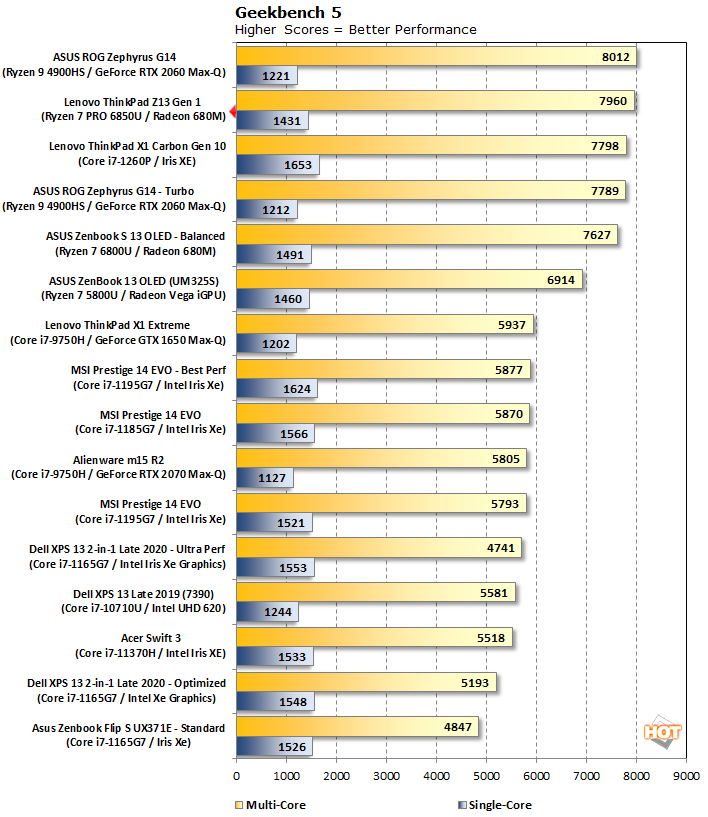
Once again, the ThinkPad Z13 Gen 1 outdoes every single ultraportable notebook on our chart in the multi-threaded test. Only the meatier ASUS ROG Zephyrus G14, which has a discrete graphics card and much heftier cooling system, can topple Lenovo here. The Alder Lake CPU in the ThinkPad X1 Carbon Gen 10 is a fair bit faster on the single-threaded side of this test, but the sheer grunt of eight full-fat CPU cores with SMT gave it the multi-threaded edge needed to nearly climb to the top.
Cinebench R23 Rendering Test
This is the latest 3D rendering benchmark from Maxon, based on the Cinema 4D R23 rendering engine. We tested both single-threaded and multi-threaded tests on all of the notebooks represented here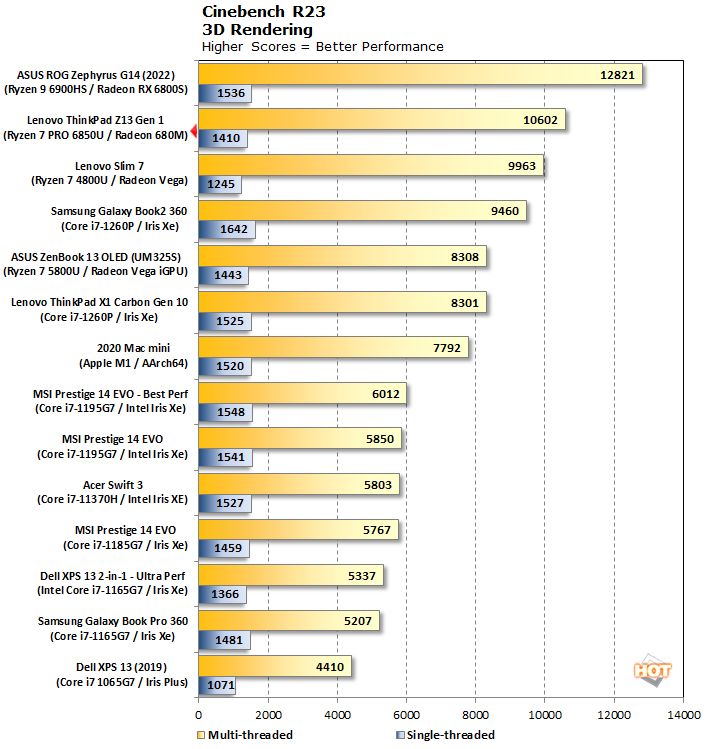
Cinebench tells largely the same story as Geekbench. The ThinkPad X13 Gen 1 has a respectably high single-threaded result, but uses all of its cores to full effect to pull ahead in the multi-threaded test. Once again, only the ROG Zephyrus G14 can beat the ThinkPad out.
UL PCMark 10
PCMark 10 uses a mix of real-world applications and simulated workloads to establish how well a given system performs productivity tasks, including image and video editing, web browsing, and OpenOffice document editing. While these scores appear to be all over the place, the systems are sorted by their overall PCMark score, which is the third (gray) bar in each cluster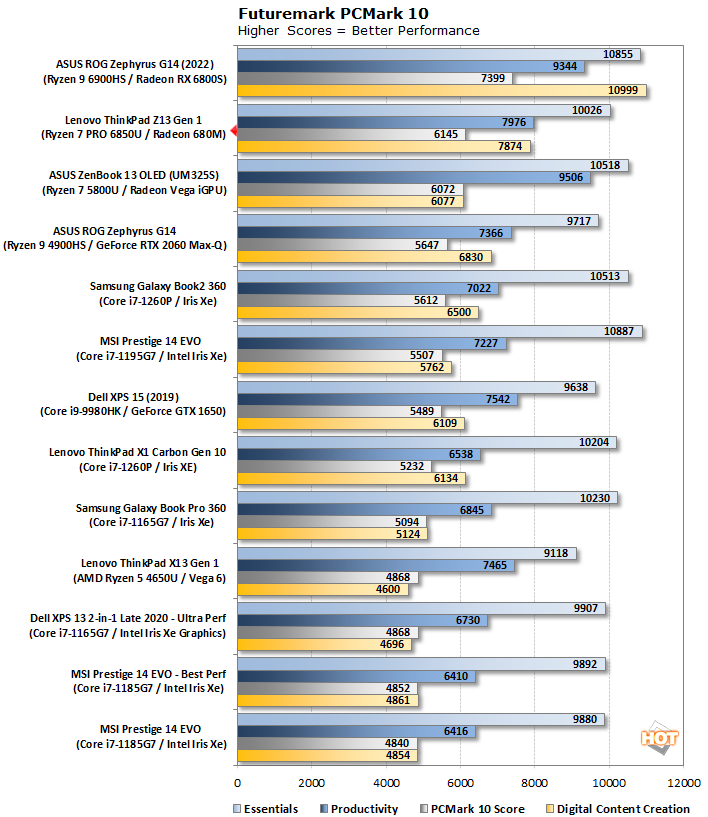
In a surprise upset, the ThinkPad Z13 beats out all the other ultraportables. Oh, wait, that's what it's been doing all along. The runner-up always seems to change in our test suite, and this time the Lenovo ekes out a win over the ASUS Zenbook 13 OLED with its Ryzen 7 5800U processor. This time, however, it seems the ThinkPad owes its win to the Radeon 680M's generous GPU chops. Winning big in the Digital Content Creation test makes up for how the Zenbook pulling ahead in both Essentials and Productivity. It's neck-and-neck here, but overall it's extremely close. So far, the ThinkPad is quite a winner.
UL 3DMark Tests
3DMark has several different graphics tests which focus on different types of systems. We start with Night Raid, which is 3DMark's targeted benchmark for laptops with integrated graphics. This test presents a solid challenge for the system's CPU and GPU engines using DirectX 12's API. We'll then move on to the even more taxing 3DMark Fire Strike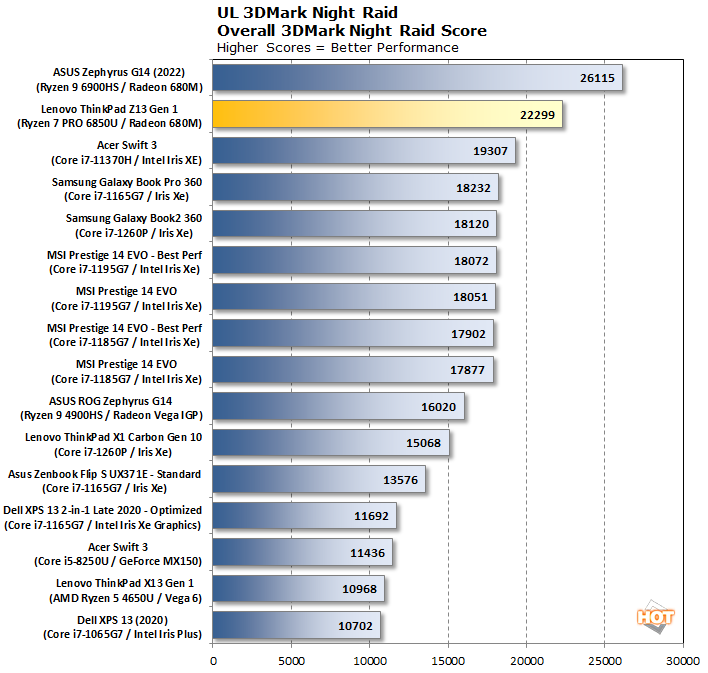
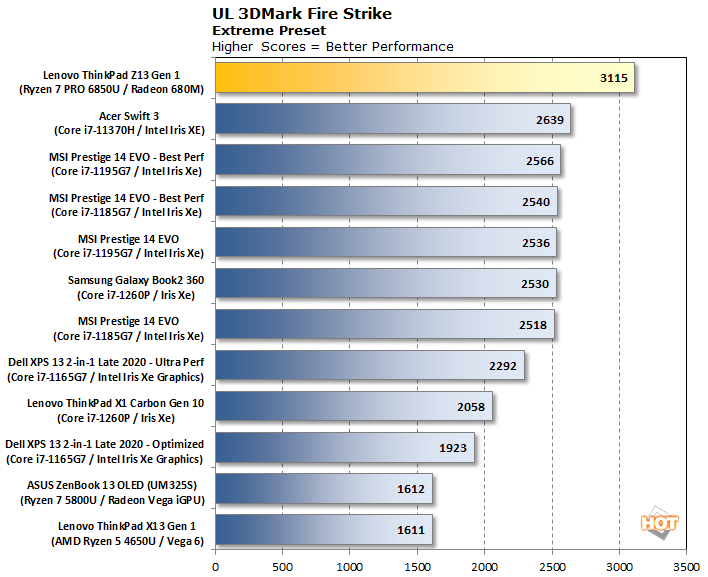
Alright, so now we're in to graphics benchmarks and the RDNA2 roots and 12 compute units in the Radeon 680M combine for relatively great performance. We say relatively because modern discrete graphics is always going to be faster, but for an integrated unit, the ThinkPad Z13's Ryzen 7 PRO and its iGPU are top of the heap by a margin of about 15% in both tests. We did run Fire Strike Ultra on the ROG Zephyrus G14's integrated graphics, and once again the superior thermals and higher power budget give it a win. As far as ultraportables go, though, the Lenovo ThinkPad impresses.
Gaming Tests with Shadow of War and Gears Tactics
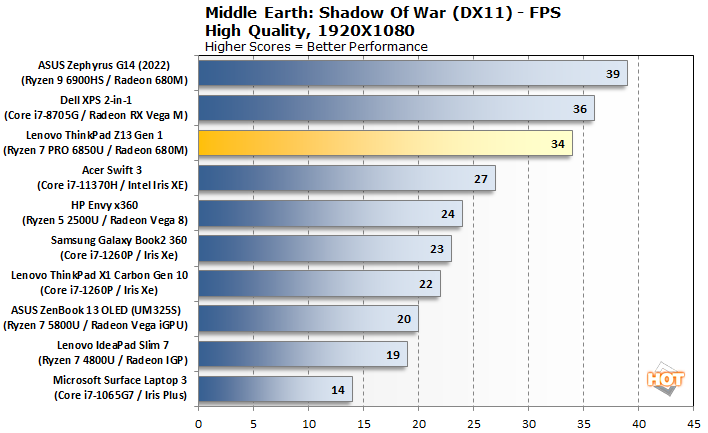
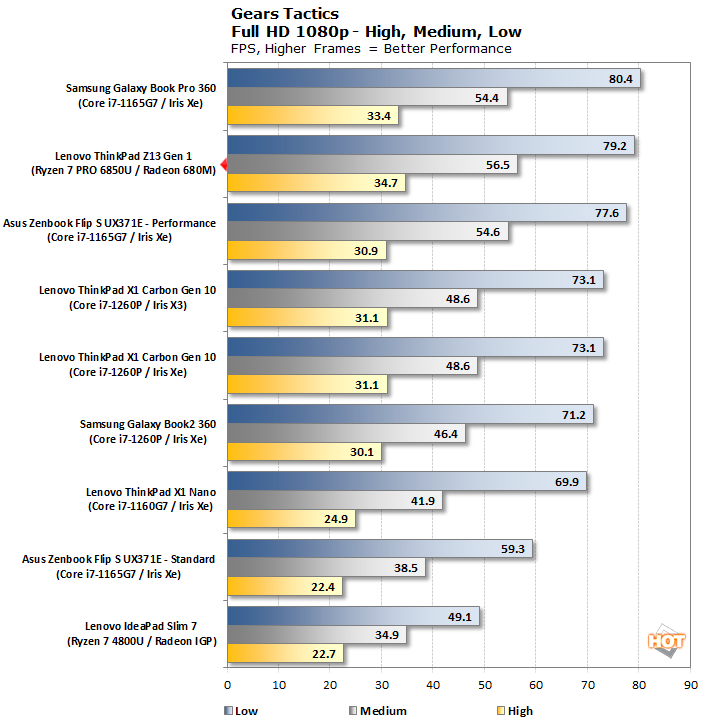
Again, the ThinkPad Z13 Gen 1 and its Radeon 680M iGPU acquit themselves very nicely. Shadow of War marks the first time that an integrated GPU in a 5-Watt package clears the 30 fps mark on High settings. It's not super smooth, but you could easily drop the details down to Medium and pick up some performance if you were going to play this for real.
As for Gears Tactics, it's basically the same story. 35 fps on High is nice, but just picking Medium adds around 70% more performance and smooths out the bumps nicely. Overall the ThinkPad Z13 could make road warrior PC gamers very happy by doing work and play equally well, all while not forcing travelers to carry big, heavy desktop replacement laptops. There are sacrifices in image quality that have to be made, as Gears Tactics shows, but all-in-all, performance is extremely solid for this pint-sized notebook's size.
Next we will take a look at battery life. And then of course we need to see how well the ThinkPad Z13 Gen 1 handles heat, how quiet it runs under a full load, and offer up our closing thoughts on this slim and sleek business-class machine.

